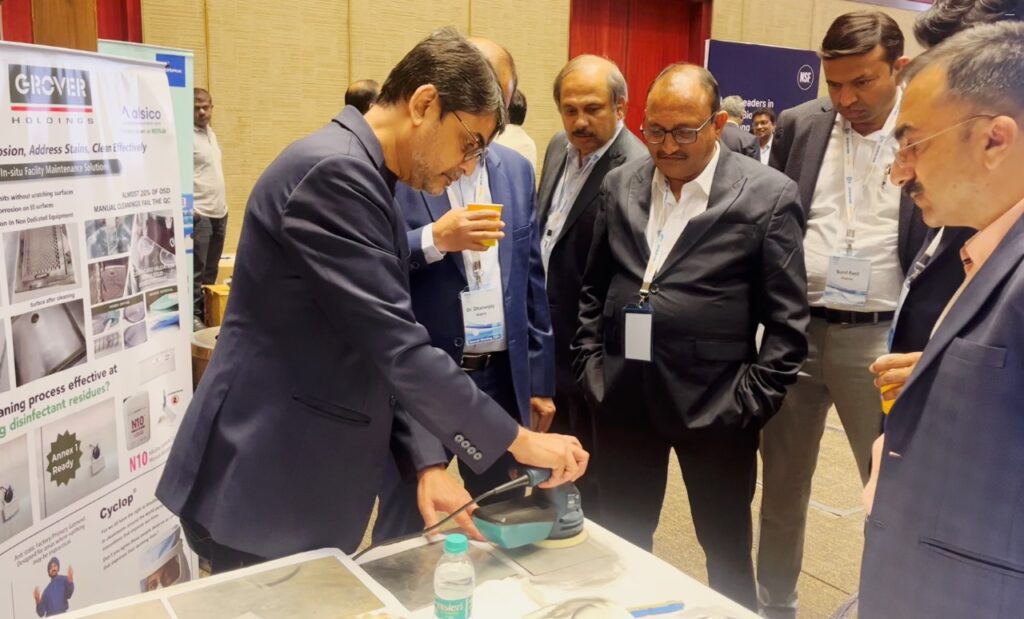
The recently held three-day Parenteral Drug Association (PDA) India Chapter’s Annual Conference 2024 in Hyderabad witnessed a strong turnout of over 600 experts from the pharmaceutical industry.
As one of the leading subject matter experts in CCIT, Headspace Analysis, Clean Room Contamination Control and Facility Maintenance solutions, we were invited by the organisers to exhibit our wide range of pharma solutions.
Over the three days at the Conference, many questions about leak testing and headspace analysis came up in discussions with the attendees. Here is a quick compilation of the 6 Frequently Asked Questions (FAQs) that our team addressed at the event:
FAQs:
Q 1. EU’s Annex 1 specifies that “Containers sealed under vacuum must be tested for the presence of vacuum…..” In this case, how can one exactly measure this vacuum?
Ans. The vacuum/pressure in the headspace of lyophilized (lyo) vials can be measured using a Laser Head which measures the absorption of the water/moisture in the headspace.
The data obtained is then converted to absolute pressure in the headspace using a precise formula.
Q 2. How does the acceptance limit for headspace oxygen affect the sizing of the machine? Why is it important to define a realistic acceptance limit?
Ans. Simply put, the lower the acceptance criteria for the percentage of oxygen in the headspace, the more the testing time, and hence the more number of lasers that may be required to test the same number of containers.
This leads to increased investments in the testing machinery and more space requirements. It is suggested to use stability studies to define a realistic acceptance limit for the oxygen percentage prior to the equipment design.
Q 3. Why does USP 1207 not recommend the re-usage of positive samples for challenging the CCIT machine results?
Ans. Since positive samples are usually taken with leak sizes (that are in microns and hence invisible to the naked eye), reusing such samples may block artificial leaks. This can lead to false results while challenging the CCIT machine results.
A viable alternative is to use a calibrated needle valve and flowmeter for using an airflow rate at a defined pressure to simulate leak sizes. As a quickly repeatable and scientific methodology, it can be easily used to challenge the CCIT machine results.
Q 4. We use dummy vials for recipe creation for the CCIT machine. What are the implications of these?
Ans. Dummy vials are usually made of solid materials like special plastic or metal. When subjected to vacuum or pressure, these materials do not exhibit the natural tendencies (called “noise”) of regular glass/plastic vials.
For example, many times the air trapped under the crimp can escape when the test chamber is vacuumized or the plastic vial may marginally distort when subjected to pressure. This “noise” is not captured during the formation of the recipes using dummy vials and may lead to false rejects when production vials are being tested.
On the other hand, real vials will exhibit variances, or ‘offsets’, when compared to these dummy vials. While some plastic materials sometimes show similar behaviour as the real vials, you can never truly capture effects such as those of trapped air.
Q 5. What are some of the common causes for false rejects and how can we minimise them?
Ans. There are multiple factors that lead to false rejects. Some of the most common causes are:
- Air entrapped under the cap
- Surface moisture on the container
- Recipes which are too tight on the acceptance criteria
- Use of unverified positive samples and dummy vials while generating recipes.
Addressing these factors can significantly reduce false rejects.
Q 6. When can we use positive samples? What are the pros and cons of using positive samples for recipe development?
Ans. While positive samples can be used to verify a recipe, they are not recommended for creating a recipe. Since positive samples are exposed to the atmosphere, external conditions can play a significant role in affecting the pressure inside the positive sample. This in turn can affect the recipe parameters.
To prevent this, it is recommended to keep the positive samples in the same room as the machine. This ensures that the machine as well as the positive samples are subject to the same environmental conditions as each other.
Needless to say, the positive samples must be tested to ensure that they are not clogged before their usage.
Summing Up
As the field of Leak Testing/Headspace Analysis continues to gain importance, it is important that users understand the concepts well to avoid problems while using these technologies.
The PDA Conference was a great platform for industry leaders to interact with the subject matter experts.
Please visit our website https://groverholdings.com or get in touch with us at vivek@groverholdings.com to know more about these topics.


One Response